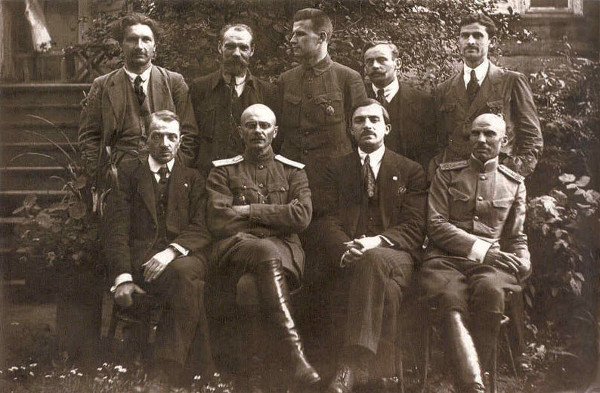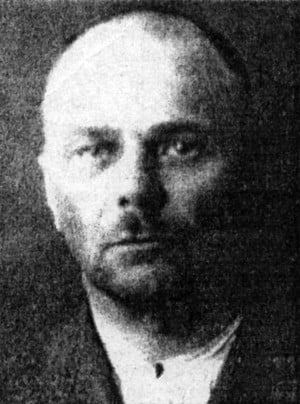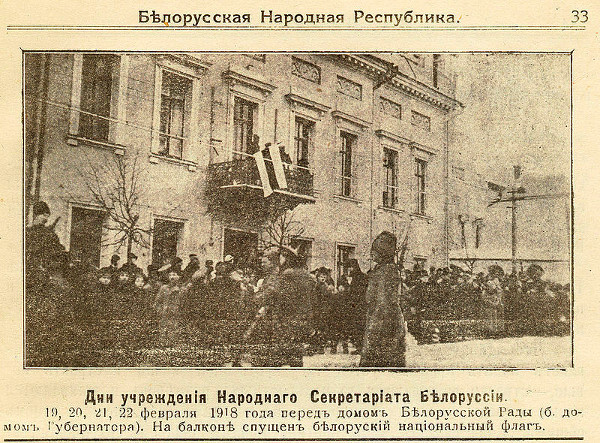95th anniversary of BNR
21- 25.03.2013, 1:29
The Belarusian People's Republic was declared on March 25, 1918.
The Rada (Council) of the Belarusian People's Republic adopted the Third Charter in Minsk that proclaimed the country's independence. The nation received its first chance to establish its own state.
Young Belarusians Jazep Varonka, Kastus Jezavitau and Ivan Serada – representatives of the generated brought up on the ideas of national revival – made invaluable contribution to formation the BNR. They tied their freedom hopes with the World War I and the February Revolution in Russia.

The first Government of the Belarusian People's Republic. Jazep Varonka is the third from the left
The opportunity became real after the negotiations between Bolsheviks and Germany in Brest in early 1918 were thwarted.
The Soviet authorities, which applied all efforts to impede the activity of Belarusian patriots, had to leave Minsk and other large cities and flee to Smolensk (Russia).
On February 21, the Executive Committee of the Council of the Belarusian National Congress declared itself the temporary authorities in the country. A decision was taken to call the founding congress that would become the first attempt of the Belarusians to define their fate on a democratic principle. The functions of the authorities were given to the temporary government – the People's Secretariat – headed by one of the leaders of the Belarusian Socialist Assembly Jazep Varonka.
Belarus was declared people's republic some weeks later. The government was reorganised as the BNR Rada headed by Ivan Serada.

Chairman of the BNR Rasa Ivan Serada
The Rada declared full independence of the BNR on March 25.
The Pahonya (chase) coat of arms and the white-red-white flag were declared the state symbols.
The BNR government made many efforts to establish the national institutions. A decree on the state status of the Belarusian language was signed; Belarusian schools and colleges, educational centres, theatres and printed houses were opened; Belarusian newspapers were published. There were plans to open a national university in Minsk.
The country's independence was recognised by a range of European states.
The BNR Rada rested on Belarusian councils in Mahilou, Hrodna, Vaukavysk, Slutsk and other towns. The work to create local government agencies was immediately started.
Germany and Soviet Russia recognised neither the BNR itself nor the right to self-determination of other nations in their territory. Nevertheless, the Bolsheviks regarded it as a real state. As they wrote in a decision of the central committee, “the power of the BNR's government should be handed over to the BSSR government”.
Due to a difficult military and political situation, the BNR Rada failed to implement the idea of the state sovereignty of the country – it found itself defenceless in the face of the Bolsheviks in the East and Polish legions in the West. The Soviet authorities saw how popular the idea of the state independence was among Belarusians. For this reason, the Belarusian Soviet Socialist Republic was declared on 1 January 1919 within the boundaries of the BNR. The government of Soviet Belarus moved to Minsk, occupied by the Red Army. The BNR Rada had to emigrate.
The proclamation of the BNR had other consequences besides the enforced declaration of the BSSR by the Bolsheviks. The local authorities founded the groups that conducted a guerrilla war against the Communists in the following decade. The guerrilla warfare often posed threats to the Soviet authorities, such as the Slutsk Uprising and massive support of General Bulak-Balakhovich by Belarusians. It was the first time in the last few decades when the Belarusians achieved their aims. A year before 25 March 1918, it was hardly possible to imagine that the nation could have its own government and state, though for a short time.










